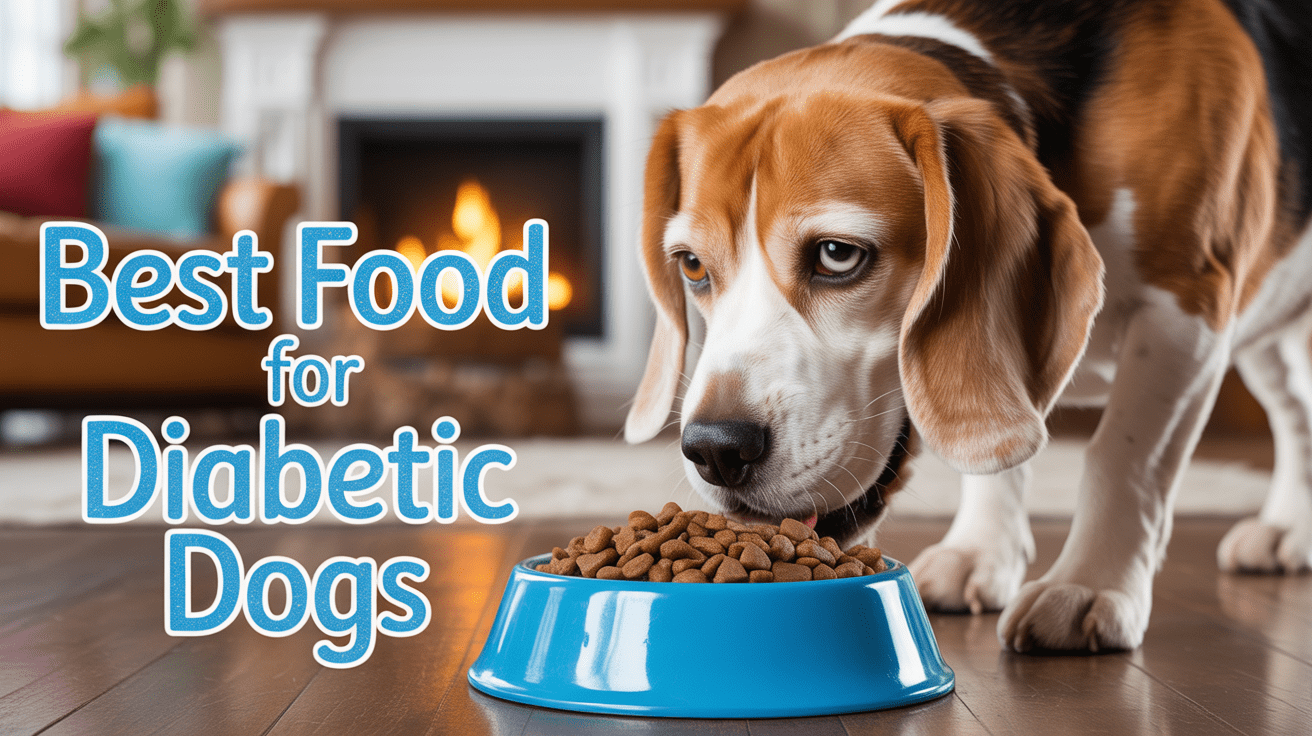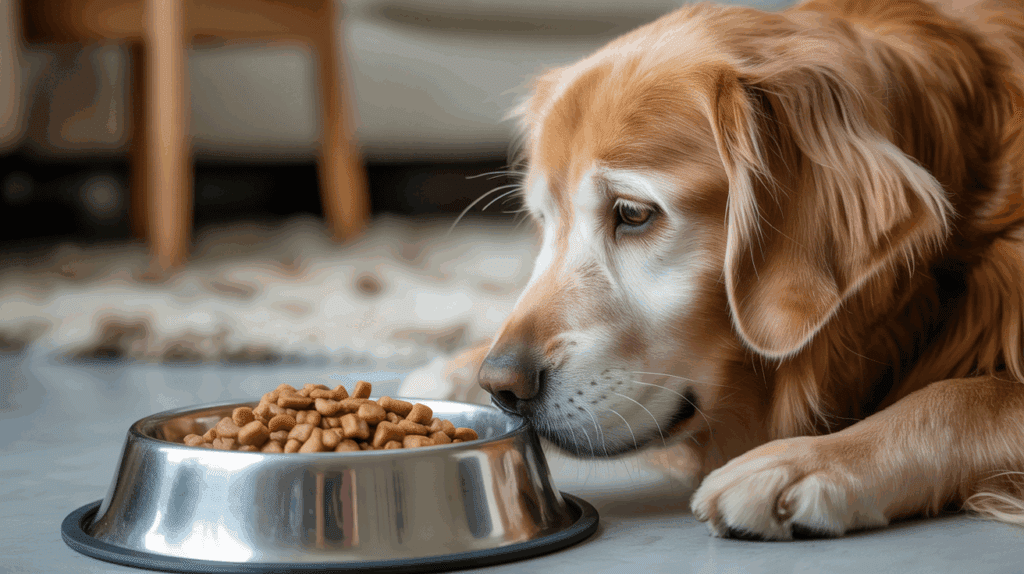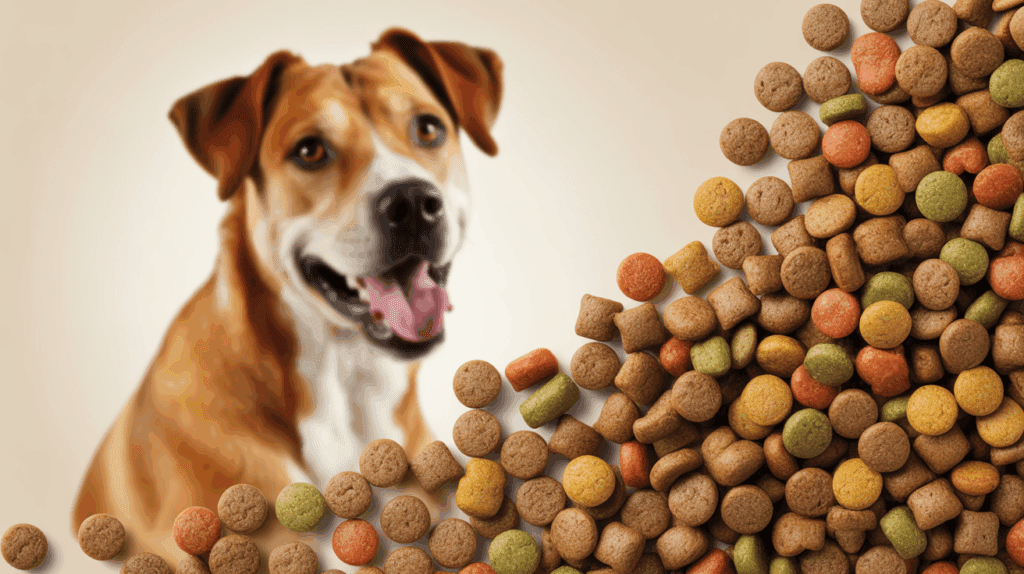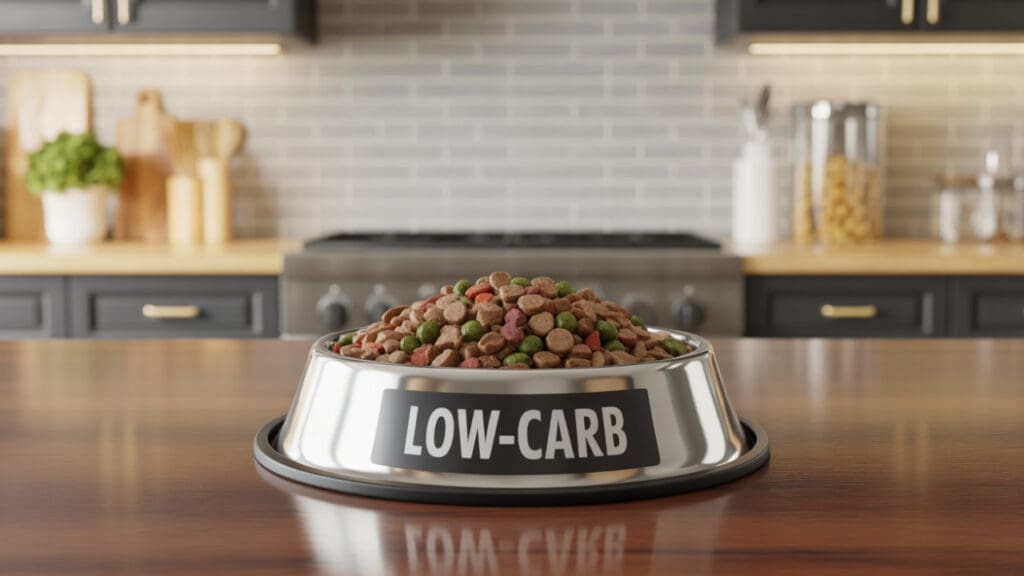
Newsletter Subscribe
Enter your email address below and subscribe to our newsletter

Enter your email address below and subscribe to our newsletter

You’re happily playing fetch with your dog, and they seem energetic and full of enthusiasm. But within minutes, they turn sluggish and weak, deflated like a balloon. Watching your canine friend’s energy rise and fall like a rollercoaster can be quite a painful experience.
Fortunately for you, low carb dog food for diabetic dogs can help regulate your canine’s blood sugar. It works by avoiding the sharp glucose spikes triggered by common fillers like corn, rice, and potatoes.
Now, many of us think that the label “grain-free” indicates low-carb. But oftentimes, these options just swap grains for another high-carb ingredient. And this is likely not ideal for your canine companion.
Veterinarians say that the best diets for our diabetic dogs should contain at least 30% high-quality protein with carefully balanced fats. Also, we should keep carbs under tight control.
Keep in mind that overlooking this can result in your vet increasing your dog’s insulin dosage. This translates to more frequent vet visits. And it ultimately costs you a lot of money in the long run.
Premium formulas may be quite pricey, running up to about $100 per bag. However, the long-term savings in reduced complications often compensate for the cost. And you can see that paid off in your dog’s steadier energy and fewer health scares.

The best diet for a diabetic dog is high in protein, moderate in high-quality fats, and low in digestible carbohydrates (ideally under 25% of calories). Look for recipes that prioritize animal meat over starchy fillers like corn, potatoes, or lentils. Consistency in meal timing and portion size is just as critical as the food itself to maintain stable blood glucose levels. Always consult your veterinarian before making any dietary changes.
Avoid: “Grain-free” foods that use high-glycemic starches, foods with sugar or molasses, and excessive high-carb treats.
“In managing canine diabetes, nutrition isn’t just part of treatment-it’s the foundation. The right diet reduces glucose spikes, making insulin work more effectively. There is no single diet for all diabetic dogs-species, body condition, preferences, and other health issues all matter.”
Managing canine diabetes starts with possibly the most important daily decision-choosing the right food. And you’ve probably heard that low carb dog food for diabetic dogs is the way to go. Indeed, such food can help regulate your pal’s blood sugar.
First, understand that when your dog consumes simple carbohydrates, a glucose spike naturally follows as a result. Good low-carb options curb this. They usually prioritize lean proteins, fiber-rich vegetables, and sometimes controlled amounts of healthy fats instead of relying on corn, wheat, or rice fillers.
But as some of us know, it can be quite a challenge to find high-quality “low carb” food. Some brands cut carbs but replace them with poor-quality fats or additives. This can stress your diabetic dog’s pancreas instead. Others may reduce carbs but still contain hidden sugars or starchy fillers.
Don’t mistake “grain-free” for “low carb.” Grain-free foods are meant for dogs that are allergic to grains. And they often use potatoes, lentils, or peas as substitutes, meaning they are still quite carb-heavy. So, always check guaranteed analysis and ingredient list, or even talk to your vet when you’re in doubt.
Know that low carb dog food isn’t just another dietary trend. It’s a clinical strategy that can help improve your diabetic dog’s quality of life. It is the main, natural way to help stabilize your canine companion’s blood sugar and reduce the risk of dangerous spikes.

Let’s take a look at the science behind low carb diets for your diabetic canine friend. Now, when your dog eats carbohydrates, their body breaks them down into glucose. This is a simple sugar that enters the bloodstream.
For a healthy dog, insulin helps move this glucose into their cells for energy. But for your diabetic pal, this insulin regulation is impaired. And that means, without regulation, your dog experiences dangerous glucose spikes and crashes.
Nutrition, thus, is very important, becoming more of a treatment rather than just simple feeding. Low carb dog food helps reduce the glucose load after your dog’s meals. It makes their blood sugar easier to manage and helps them be more energetic throughout the day.
Veterinary experts say that a good nutritional balance for our diabetic dogs involves high-quality protein, moderate fat, and truly reduced carbohydrate content. It’d also be great to incorporate fiber in our dog’s diet.
Now, a high fat low carb diet for dogs can indeed provide your canine companion with sustained energy without relying heavily on glucose. However, know that you shouldn’t go to the extreme. If your dog consumes too much fat, especially poor-quality fat, they may be at risk for pancreatitis or obesity.
You can opt for a homemade, DIY approach. But do this under professional guidance using lean meats, non-starchy vegetables, and vet-approved supplements. The recipes will require precision to meet your dog’s nutritional needs.

Reducing carbs matters-but for diabetic dogs, fiber type is even more important. The right balance of soluble and insoluble fiber can dramatically improve glucose control.
Sources like beet pulp, guar gum, and psyllium dissolve in water to form a gel-like substance in the gut. This slows gastric emptying and carb digestion, creating a natural “speed bump” for sugar absorption. The result: fewer sharp glucose spikes after meals.
Found in cellulose and lignin, insoluble fiber doesn’t dissolve. Instead, it adds bulk, regulates intestinal transit time, and helps dogs feel full-key for weight control. Since obesity worsens diabetes, insoluble fiber is an underappreciated ally.
Studies show dogs with naturally occurring diabetes have better glycemic control on high-insoluble-fiber diets. In one trial, dogs fed 6.0 g/100 kcal of fiber had improved fasting glucose and reduced urinary glucose compared to those on 2.6 g/100 kcal diets.
You might have experience running around the grocery store looking for the best high protein low carb dry dog food for your diabetic friend. And this, as you know it, can be rather overwhelming. The “healthy” and “grain-free” labels only add to the confusion.
Now, let’s focus on the three main nutrients: protein, fat, and digestible fiber.
Veterinarians usually recommend that we look for dog foods with a minimum of 30% protein from high-quality animal sources to support lean muscle and stable energy. The carb level should stay below 20–25% of total calories.
Fats in these foods should fall in the 10–20% range. Ideally, they should come from clean sources like chicken fat, fish oil, or flaxseed oil. Such healthy fats can provide your dog with the required energy without stressing their pancreas. Dog food high in fat low in carbs can also help with satiety, thus reducing overeating and weight fluctuations.
For overweight dogs, 10-20% fiber in dry food is good, while dogs in a healthy weight range can have 5-15% fiber in their dry food diet. This can further provide your diabetic dog with the satiety and glucose regulation they need without causing digestive issues.
Let’s take a look at the cost. Premium brands that meet such nutritional thresholds can be quite expensive. You’re probably looking at $60 to $100+ per bag. It may seem steep. But experts point out that better glycemic control can translate into fewer costly insulin shots. And that means fewer vet visits, too.
| Brand & Recipe | Estimated Carbs* | Protein % | Fat % | Fiber % | Key Feature |
| Royal Canin Glycobalance | ~10%** | 35.0% | 10–14% | 10.0% | Specialized glucose control formula |
| Hill’s Prescription Diet w/d | ~15%*** | 20.7% | 11.4% | 20.0% | Multi-benefit digestive support |
| Purina Pro Plan OM | ~18%**** | 32.0% | 8.5% | 12.0% | Amylase inhibitor technology |
| Victor Senior Healthy Weight | ~42% | 27.0% | 11.5% | 4.5% | High meat protein, joint support |
Important: Always confirm nutrition specs with the manufacturer or your veterinarian, as formulations can change and batch analysis may vary.
Perhaps you’re not that confident in the commercial options out there. Maybe preparing meals at home feels like the ultimate way to control what your diabetic dog eats. And yes, with the right ingredients, quality, and portion size, those low carb homemade dog food recipes of yours can help reduce your canine’s blood sugar spikes.
The first thing you’ve probably seen on the internet surrounding this topic is that protein is crucial. That usually causes pet parents to focus too heavily on this single nutrient, and that’s not ideal. You should try to balance other essential vitamins, minerals, and fiber, too.
Other than lean meats, incorporate some non-starchy vegetables like zucchini, spinach, or broccoli. You should also add moderate amounts of healthy fats such as fish oil and flaxseed oil. Sometimes, you can add supplements like calcium or taurine to meet your dog’s nutritional needs. You don’t want to deal with issues because of deficiencies.
Veterinary nutritionists say that the safest approach is to follow a recipe designed by a board-certified veterinary dietitian. Portion control and consistent meal timing are just as important. And the recipe will need to be balanced, measured, and customized to your dog’s specific weight, activity level, and insulin requirements.
From a cost perspective, preparing your dog’s meals at home might reduce expenses in the long run. You can even buy ingredients in bulk to save a few extra bucks.
That said, you will likely need to invest in some supplements. And there’s possibly a consultation fee you need to pay your vet nutritionist. But you may find the control and transparency worth the effort in the end.
Now, what kind of snacks or treats can you give your diabetic dog? If you’re thinking about getting commercial dog food, know that many of them are loaded with starches, sugars, and fillers. These can quickly destabilize your canine’s blood sugar.
Learn to look past labels like “healthy” and “natural.” More often than not, these treats contain hidden carbs in the form of honey, molasses, or rice flour. So, those biscuits or soft chews may just spike your dog’s glucose level just as quickly as candy would in us humans.
Like the wellness low carb dog food we’ve talked about, the safest treats for your diabetic dog should be high in protein, moderate in fat, and virtually free of simple carbs. You can opt for freeze-dried chicken breast, turkey jerky, or salmon bites.
If you’re a DIY enthusiast, try sliced cucumber, green beans, or small pieces of boiled chicken. These are all great options as low carb treats for dogs, and they are quite cost-effective.
Just make sure not to overfeed your canine companion, as they can add calories. As a general guide, your dog’s treats should never make up more than 10% of a diabetic dog’s daily caloric intake.
Take cost into consideration, too. Premium treats that are diabetic-friendly for your dog can cost two to three times more than regular biscuits. So, to keep your financial stress low, perhaps you can rotate between commercial high-protein treats and simple DIY options.
Well, you might have heard a thing or two from a friend about switching to low carb dog food for diabetic dogs. It sounds simple, but reality hits harder than that. Let’s take a look at some of the widespread myths and misconceptions that can prevent you from making common mistakes, save you money, and most importantly, protect your dog’s health.
The first misunderstanding is the idea that “grain-free” equals “low carb.” You should know that grain-free options are usually hypoallergenic, meant to help cut grains rather than carbs. That means grain-free diets often replace wheat or corn with potatoes, peas, or lentils. These are ingredients that can be just as carbohydrate-dense. They don’t help your dog’s blood sugar.
Another misconception involves fat. A good number of pet parents think that high-fat formulas are dangerous, but that isn’t entirely true. Dog food high in fat low in carbs can actually support better glycemic control. You just need the right balance. Choose high-quality fats and monitor the portion sizes.
Some of us may think that only premium brands are safe. Now, it’s generally true that high-quality foods are often more expensive. But the main things to look out for are the ingredient quality and proven nutrition. Even DIY options can work well, and these are unlikely to cost you a fortune.
Now, choosing the right food is one part of the equation. You’ll still need to commit to a long-term feeding strategy. Your diabetic dog will need your help to balance that safety and nutrition with their food, overseen by your vet, of course.
To begin with, you shouldn’t adjust your dog’s food too frequently, especially not without talking to your vet. Even small adjustments can alter the carb levels and affect your canine’s blood sugar and insulin needs.
Meal timing and portion control are just as important. You should make sure to feed your diabetic dog on a predictable schedule. And this should align with their insulin administration. Don’t skip meals, overfeed your dog, or offer too many treats. They can all disrupt the delicate balance.
Vet experts say that the safest approach is to carefully choose a diet and stick to it. You should measure the food with precision, keep a feeding log, and use glucose monitoring tools at home to catch fluctuations early. After that, monitor the results with regular vet checkups.
Definitely, your long-term planning should involve the consideration of costs. Specialized low carb formulas will cost more than regular dog food. But it’s usually worth it, especially since the effort can reduce the need for emergency vet visits and insulin adjustments over time.
If you’re a budget-conscious dog parent, try alternating between commercial formulas and vet-approved homemade meals. You can still manage your expenses without sacrificing your canine’s health this way.
You might still have questions regarding managing canine diabetes. To make things easier, here are some of the most frequently asked questions surrounding the topics. They should help you cut through myths, provide practical guidance, and give you the confidence to make informed choices for your dog.
You should opt for something that is high-protein and low-carb, ideally designed for blood sugar stability. Check with your vet for options (specifically for your dog) with the right balance of nutrients without excessive starch.
Foods that rely on animal proteins, fiber-rich vegetables, and limited starches qualify as low carb. You should always check the guaranteed analysis, not just the marketing label.
Complex carbs like peas or lentils can sometimes be included in moderation. These digest more slowly. However, you need to portion them carefully under veterinary supervision.
You should avoid foods with corn, white rice, wheat, or sweeteners like molasses. These cause rapid glucose spikes and destabilize diabetes management.
Lean meats, green vegetables, and legumes with slow digestion rates are considered low glycemic. They can help maintain steady glucose levels.
Low carb diets minimize blood sugar spikes after your dog’s meal. This makes insulin therapy easier, and it improves long-term energy stability.
Yes, but do so only with veterinary guidance. Your homemade food should include supplements to avoid deficiencies and maintain balance.
Protein provides steady energy, supports muscle mass, and avoids the glucose surges that are caused by excess carbs.
They can help with glucose control. But you must use high-quality fats. Excessive or poor-quality fats raise the risk of pancreatitis.
Yes, if they are low carb treats for your dog, such as freeze-dried meats or crunchy vegetables. Keep the portions small and controlled.
Managing diabetes in your dog is not all that clear-cut. There’s no single magic formula, and the process will involve tons of research and talks with your vet in order to make a smart choice that can keep your canine’s blood sugar steady.
The bottom line is that you should opt for a diet that’s high in quality protein, moderate in clean fats, some fiber, and truly low in fast-digesting carbs. This way, your diabetic dog can have the best chance at stable health.
Remember to avoid common mistakes like assuming “grain-free” is low carb. You should invest in trusted formulas or carefully guided homemade recipes. Also, work closely with your vet to monitor your dog’s well-being.
Apply your knowledge and make your choice with confidence. And you shall have a healthy canine companion that stays with you for the years to come.
Have you tried a low carb diet for your diabetic dog? What is your go-to brand? Or do you have any favorite recipes? Let us know in the comments below.